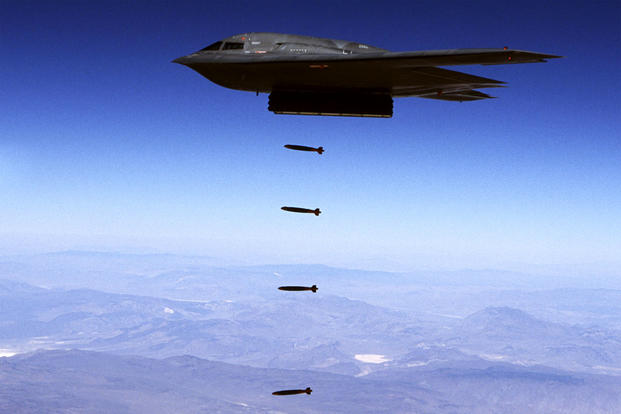The B61-12 guided nuclear gravity bomb has gone through its first series of tests on the B-2 Spirit stealth bomber.
The Air Force, together with the Department of Energy's National Nuclear Security Administration, earlier this month released a B61-12 non-nuclear test assembly from the Spirit. The kit included a NNSA-designed bomb assembly and the Air Force's acquired tail-kit to be used on the B61-12 variant of the bomb, according to a Department of Energy release.
"These qualification flight tests demonstrate the B61-12 design meets system requirements and illustrate the continued progress of the B61-12 life extension program to meet national security requirements," said Brig. Gen. Michael Lutton, NNSA's principal assistant deputy administrator for military application.
"The achievement is also a testament to the dedication of our workforce and the enduring partnership between NNSA and the U.S. Air Force," he added in the release.
Related content:
- F-35 Could Carry B61 Nuclear Warhead Sooner Than Planned
- Lawmaker: US Should Field New Nukes After Russia Violated Treaty
- Air Force Advances Testing of New Nuclear Gravity Bomb: General
The two non-nuclear system qualification flight tests of the B61-12 took place on June 9 at Tonopah Test Range in Nevada, officials said. They were conducted by the 419th Test & Evaluation Squadron at Edwards Air Force Base, California.
The exercises marked first such "end-to-end qualification tests on a B-2A Spirit Bomber for the B61-12," the release said. "The tests are part of a series of joint tests to demonstrate both the aircraft's capability to deliver the weapon and the weapon's non-nuclear functions."
Part of the system's hardware is designed by Sandia National Laboratories and Los Alamos National Laboratory and manufactured by the Nuclear Security Enterprise plants. Meanwhile, Boeing Co. has designed and manufactured the tail-kit assembly under contract with the Air Force Nuclear Weapons Center, officials said.
Using the B61-12 will help consolidate and replace the existing B61 bomb variants in the U.S.'s nuclear stockpile, the release said. The first completed bomb kits are scheduled to debut sometime in fiscal 2020.
In May, top Air Force officials announced trials with the B61-12 were progressing successfully.
"We've already conducted 26 engineering, development and guided flight tests," said Lt. Gen. Jack Weinstein, deputy chief of staff for strategic deterrence and nuclear integration. "The program's doing extremely well."
The B61-12 modification program, which has been in the works for at least seven years, is slated to be carried by the B-2, as well as the future B-21 Long Range Strategic Bomber, known as the Raider.
The F-35 Lightning II Joint Program Office has also been working on integrating the latest modification into its weapons arsenal.
The F-35 was designed with a requirement to carry a nuclear payload. In 2015, an F-35 flew with the B61-12 to measure its vibration in the aircraft's weapons bay.
Both of the fourth-gen fighters will be able to deploy the B61-12 bomb. The B61-12 also conducted its third and final developmental test flight aboard an F-15E in 2015.
-- Oriana Pawlyk can be reached at oriana.pawlyk@military.com. Follow her on Twitter at @oriana0214.
The United States has taken a significant step closer to developing a nuclear bomb that some say could be the most dangerous ever produced. The Department of Energy's National Nuclear Security Administration announced earlier this month that it has completed the development and testing phase of the B61-12, the first-ever guided nuclear bomb. By 2020, the US will commence full-scale production.












